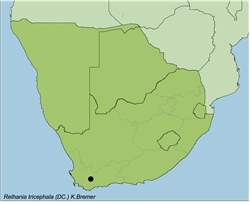Names and synonyms
Relhania tricephala (DC.) Bremer
=Polychaetia tricephala DC.
=Polychaetia triflora DC
=Relhania triflora E. Mey. ex DC, pro syn.
=Nestlera tricephala (DC.) Harvey
=Nestlera angusta Compton
Type
Drege, J.F. 572, South Africa, Cap de Bon Esperance (G, P)
Derivation of names
Relhania = after Irish-born Richard Relhan (1754-1823), botanist, plant collector, bryologist, lichenologist, one of the founders of the Linnean Society, rector in Lincolnshire and author of Flora Cantabile.
tri- = three; kephale = head
Diagnostic characters
Leaves narrow, linear
Capitula small, in a cyme
Description
A moderately branched shrublet, 0.3-0.5 m high. Stems erect, tomentose, leafy, becoming glabrous and nude and marked with leaf-scars. Leaves spreading, 6-15 x 0.5-1.8 mm, canaliculate with involute margins, linear or narrowly obovate-oblong, glabrous or tomentose dorsally, densely lanate and whitish above, obtuse-rounded. Capitula 3-12 together in terminal cymes. Peduncles absent, or on lowermost capitula, up to 2 mm long. Involucre urn-shaped 1.5-4 mm wide. Involucral bracts 20-35, outer ovate, innermost spatulate with a spreading, apical limb. Receptacle flat-convex, epaleate, but sometimes shortly squamose. Ray florets 7-15, tube 1-1.8 mm long, lamina elliptic, 2.2-3.5 x 0.9-1.2 mm, 4-veined. Disc florets 10-25, sterile. Pappus crownlike, of connate scales, up to 1.3 mm long. Cypselas of disc florets flattened, oblong, 1.2-2 x 0.3-0.4 mm, glabrous or laterally sparsely pilose; in ray florets elliptic-oblong, 1.5-2.2 x 0.5-0.8 mm, densely villose.
Flowering time
Mainly in September (to November).
Distribution
Known from the Ceres, Worcester, De Doorns and Montagu divisions.
Known from fewer than 10 specimens.
Habitat
Sandy or clayey soil on the mountain plateau and flats below the mountains. It is also found on disturbed ground, e.g. along roadsides.
Notes
R. tricephala is closely related to R. corymbosa and R. relhanioides. It is distinguished from the latter by the capitula arranged in cymes and from R. corymbosa in foliage and length of peduncles. The leaves are often somewhat twisted in R. tricephala and usually straight or slightly incurved in R. corymbosa.
References
BREMER, K. 1976. The genus Relhania (Compositae). Opera Botanica 40.
KESTING, D. & CLARKE, H. 2008. Botanical names, what they mean. Wild Flowers of the Cape Peninsula, 3rd revised edition. Friends of Silvermine.
